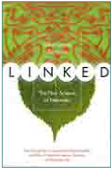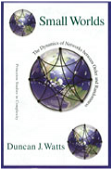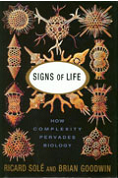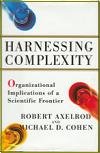

Watts, Duncan, J.:
Small Worlds: the dynamics of networks between order and randomness,
Princeton University Press, 1999, ISBN 0-691-00541-9. ( 280 pages, 160*240 mm)
Why are there only six handshakes between every human being? Why does everyone in Hollywood know the actor Francis Bacon? Duncan Watts explains how this can be.
This book is about Watts´ pioneering research into networks which was performed by aid of mathematical models and computer programming, and can be seen as a bridge between the earlier network research, by among others Paul Erdös, and the later complexity theory research, for instance by Barabasi.
Watts gives results important to the understanding of epidemics, spreading of deices, phase transitions, and more.
Watts´ book is already a classic. The math is not too difficult, but you should have a fairly good understanding of undergraduate level mathematics and follow the explanation (with paper and pencil) in order to really enjoy the book. This is not for the intellectually lazy person.
Ricard Solé and Brian Goodwin:
Signs of Life,
Basic Books, 2000, ISBN 0-465-10927-7. (322 pages, 169*240 mm)
Ricard Solé and Brian Goodwin have written an easy to read exposé over complexity phenomena and about how simple rules create complex patterns in the natural world, and how these patterns can be found in man made systems such as cities and traffic.
If you spectrum analysis heart beats you will find in the frequency window that a healthy heart beats with all frequencies (at one and the same heart beat); the embedded possibilities are always present. The unhealthy heart beats with less and less frequencies as it gets sicker until, just before heart arrest, it locks on one frequency only.
Parallels: ecosystems, economies-the more players, the healthier and stronger the system will be.
Diversity is better than uniformity. Purchase the book and read!
Albert-László Barabási:
Linked, the New Science of Networks,
Perseus Publishing, 2002, ISBN 0-7382-0667-9. (280 pages, 157*235 mm)
Exciting, but a bit wordy here and there, one can tell that the chapters of this book where written one by one with quite some time in-between. But never the less, Barabasi tells the story of how complexity theory results from research on the Internet came about-you learn step by step, and it is thrilling.
The Internet is scale free, the number of links to websites and number of websites follows a power law. This is typical of complex systems such as ecological systems.
Tens of thousands of surveillance cameras use the Internet, this worldwide nerve-net, so the Internet has eyes. What will happen next? What dynamic effects can emerge as the net continues to grow? Well, one such thing sis parasitic computation.
Barabasi is a Hungarian physicist living in the USA. His research interests are granular media, micro ratchets and the Internet. Barabasi´s website is http://www.nd.edu/~alb/ .
If you use the Internet, create products for the Internet or build your activities on the Internet, or are just intellectually curious, you will enjoy and benefit from reading Linked, the New Science of Networks.

Mark Buchanan:
Ubiquity, the science of history…or why the world is simpler than we think,
Phoenix, 2001, ISBN 0-75381-297-5. (230 pages, 129*198 mm)
Ubiquity means omni presence, part of everything. What is it that has this quality? The answer is power laws. Power laws can be used to describe everything from forest fires to stock exchange fluctuations and every in-between.
Really thrilling are the conclusions drawn from this fact: 1/ there is no typical size. Small insignificant occurrences have the same cause as large catastrophes, 2/ history is important and lays embedded in the present as small trigger points for coming events, 3/ systems that drive themselves to critical condition (edge of chaos), and most natural systems, human societies included, are of this kind, exhibit power laws, 4/ the world is in truth unpredictable.
Mark Buchanan, doctor of theoretical physics and former contributing editor of Nature and New Scientist, has written an informative and easy to read popular science basic book on the subject. The book is free of mathematical formulas so even the mathematically ignorant will fully enjoy the book. Recommended!

Lewin, Roger:
Complexity, Life at the edge of chaos,
2nd edition, Phoenix 1999, ISBN 0-75381-270-3. (230 pages, 129*198 mm)
This is a good non-mathematical introduction to Complexity Science. Roger Lewin lets you meet many of the leading names in complexity theory as he presents and discusses their findings, ideas, and opinions.
This easy going text is a good expose of the subject. If I should complain about anything it is the quality of the paper the text is printed on. Like so many paperback editions it suffers from being printed on self-destruction paper with to much bending stiffness. Otherwise it is good. There is a collection of 30 photographs printed on eight leafs of excellent paper quality in the mid section.
A good easy to read introduction. Recommended
Axelrod, Robert, M. and Cohen, Michel, D.:
Harnessing Complexity: organizational implications of a scientific frontier,
Free Press, 1999, ISBN 0-684-86717-6. (184 pages, 143*220 mm)
The authors of this book are not just anybody. Axelrod, a superstar in complexity theory, is one of the founders of the Santa Fe Institute, while Cohen, a professor of the University of Michigan, is well known for his research into organizations and complexity.
This is a comprehensive, non-mathematical, summary introduction to complexity theory. The text is a bit dry, although there are examples that illuminate the theory.
This book alone will not make you happy, it's to shallow for that as it only skims the subject in an atempt to cover everything in a few pages. But read together with for example the introductions to complexity by Lewin or Buchanan, it will broaden your understanding. I do recommend this book. I feel it is one of those books that might benefit from a second reading a while after you have put it down.
Lewin, Roger and Regine, Birute:
Weaving Complexity & Business,
Texere 2000, ISBN 1-58799-043-1. (340 pages, 150*230 mm)
This book is the attempt by Lewin and Regine to apply Complexity Science to business organization and human resource. They do not really succeed.
The print is excellent on good quality paper, but the text and the examples leaves me rather unimpressed. Maybe it is because we come from slightly different cultures. Mine is an individualistic culture, where people naturally cooperate and the distance between different social strata is short.
The thesis put forth by Lewin and Regine could be summarized in: you should be nice to people especially so if you are an employer and/or manager. But you did know that already, did you not?








